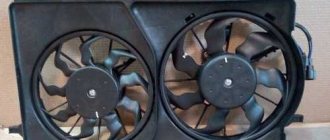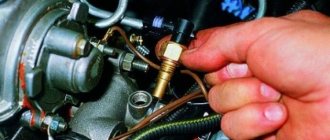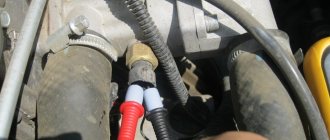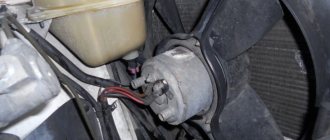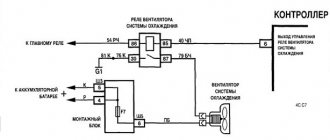Everyone probably knows how the stock 4-blade fan on the 2110 works - vibration, a fairly strong hum, a drop in voltage and engine speed. My buzzing got louder, something went wrong))
Of course, it’s not worth changing to the factory one; now there is a choice of more productive systems. At least take the 9-bladed one from Priora.
But due to my layout under the hood, I needed to move the fan in front of the radiator.
Of the VAZ models, only Niva 21214 has radiators in the front. The choice fell on them. Modern fans have a complex blade profile and there is an opinion that if they are turned on in reverse, the performance suffers and unnecessary noise appears. I didn’t want to test it myself, so I didn’t even bother with Prioro/Kalina fans. Nivsky and costs nicely)) only 2000 rubles)
The installation turned out to be the simplest, it almost stands up on its own)) I put a 9 mm oxygen hose on its standard legs...
I cut two chopsticks from a water pipe of suitable diameter and made cuts to allow water to flow out.
I placed the fan 3-4 mm from the radiator and welded it in place to the TV
In the upper part, I decided to use the standard mounting method for the Niva (the radiator presses the fan to the body). On the right, there was already metal in the body just right, up to the support shoulder on the fan
On the left there was a cutout and there was no stop...
No problem))) Cut a rectangle from somewhere, do a little welding and you’re done.
Now there's a lot of space in front...
I decided to connect them in series so that they would spin more slowly and not make any noise.
Started it up and warmed up the engine. I'm waiting for the fans to come on. I wait, I wait, I don’t hear anything... I leaned into the cracks to look, but they were spinning))) Almost silently! There was no drawdown when turned on, the speed did not jump. If you don’t look, now you won’t know whether they work or not.
In general, they made me very happy)))
The control circuit can be converted to a stepped one - a two-mode thermal relay in the radiator for two fan rotation speeds (sequential activation - 1st speed, parallel activation - 2nd speed), and for those in January, you can do a two-stage control of the brains. It might come in handy in the hottest weather. But even with sequential activation, the performance is higher than standard, so most people will not need the second speed)
Let's look at a couple of examples of how you can improve engine radiator cooling :
Niva radiator fans for VAZ 2110
Fan connection diagram in carburetor and injection engines
The control of forced radiator airflow in carburetor and injection engines of the VAZ-2110 is significantly different. Firstly, the fan switch located on the radiator housing is responsible for everything. It is set to a certain coolant temperature. Usually this is 105-107 o C. When the coolant heats up to this temperature, the sensor is triggered, sending a signal to the fan relay. It closes the electrical circuit, driving the electric motor.
Turning on the cooling fan of a VAZ-2110 with an injection engine occurs somewhat differently. In engines equipped with an electronic control unit, there is no sensor on the radiator. Its place was taken by a temperature sensor located on the thermostat pipe. When the coolant heats up to a temperature of 105-107 o C, it sends a signal directly to the controller, which makes the decision to turn on the fan. It transmits an electrical impulse to a relay, which turns on the electric drive.
Constantly running fan
In some situations, the cooling fan may run continuously, regardless of whether the engine is cold or hot. In this case, there may be various reasons, corresponding methods for checking the malfunction, as well as ways to solve the breakdown.
| Causes | Diagnostics | How to fix the problem |
| Open circuit in the coolant temperature sensor or its circuits | The “Check engine” lamp is on. The sensor and circuits need to be checked with an ohmmeter | Replace sensor |
| The electric fan relay contacts do not open | Check with a multimeter | Replace relay |
| The injection system control unit or its circuit (ECU) is faulty | Check the unit at a specialized car service center | Replace the ECU firmware or the unit itself |
| (Carburetor) Radiator thermal switch contacts do not open | Disconnect the terminals from the thermal switch terminals. After this, the electric fan will stop working. | Replace thermal switch |
Alas, sometimes even after such thorough and detailed checks, the cooling system fan on the VAZ 2110 still does not turn on. In this case, the car owner has no choice but to contact a service station.
Injection sensor for turning on the blower device. Proven and reliable car services will be able to conduct full computer diagnostics of the cooling system and determine the reasons for the non-working cooling fan. The problem may be much larger than a blown fuse.
Don't be afraid to turn to specialists, even if you consider yourself an experienced auto mechanic who has always solved your car's problems on your own. Modern equipment, a professional approach, computerization of car services - all this allows you to quickly determine the causes of malfunctions, which, according to your old-fashioned method, would have taken several days. Auto repair shops also have their advantages.
Possible faults
If the VAZ-2110 cooling fan does not work, do not rush to contact a car service center. You can determine the cause of the malfunction yourself. Moreover, it is not at all necessary to have special skills for this.
The cooling system fan may not turn on due to:
- electric drive malfunctions;
- blown fuse;
- faulty thermostat;
- a failed fan switch (temperature);
- faulty relay;
- broken electrical wiring;
- faulty expansion tank plug.
Electrical circuit malfunctions
If everything is fine with the tank cap and there are no problems with pressure, then the causes of the radiator cooling malfunction should be sought in its electrical circuit.
- The search begins with checking the functionality of the fuse marked F7. To do this, you have to get to the mounting block. Check the quality of the contacts and the presence of traces of oxidation. If everything is good here, we move on. If the contacts are broken, simply clean them, or simply change the fuse. This is a small financial cost.
- The next place to check will be the VAZ 2110 fan switch sensor. You do not have to go to a specialized service station to check the efficiency of the sensor. This is done in a garage: Warm up the engine of your car to above 100 degrees Celsius;
- Turn off the engine, then start the engine again;
- Lift the hood and remove the terminal from the VAZ 2110 fan sensor;
- If after removing the element the fan begins to spin, then the unit is working properly, but there are problems with the sensor;
- When on a VAZ 2110 the cooling system fan does not turn on after disconnecting the terminal, the situation is the opposite - the fan does not work, but the sensor is in good condition.
- The commutator brushes are worn out;
- The trim on the right side of the console inside the cabin is removed by unscrewing two screws;
How to check the thermostat
The function of the thermostat in an internal combustion engine is to regulate the flow of coolant, directing it in either a small or large circle. While the engine is cold, its valve blocks the flow of coolant into the cooling radiator. This allows the engine to warm up faster.
Check the thermostat by determining the temperature of its pipes by touch. When the engine is warm, they should all be hot. If the pipe leading from the thermostat to the cooling radiator is cold, the locking device is faulty.
How to check the sensor
One of the most common reasons why the VAZ-2110 cooling fan does not turn on is a non-working sensor for its activation (for carburetor engines) or a temperature sensor (for injection engines). Let's consider ways to check them for different engines.
In a car with a carburetor engine, you must turn on the ignition and short-circuit the two wires going to the sensor. The fan should turn on. If this does not happen, the problem is definitely not with the sensor.
For injection cars, it is necessary to warm up the engine to operating temperature and disconnect the sensor connector, disconnecting it from the vehicle’s on-board network. In this case, the controller must start the fan in emergency mode. The electronic unit perceives this as a failure in the cooling system and forces the fan drive to operate in constant mode. If the drive starts, the sensor is faulty.
Content
An important design element of every car is the cooling system. Many people associate its work with removing heat from the engine, but these are not all the tasks that this system performs.
Recently, tuning of the cooling system of the VAZ 2114 has been increasingly carried out. Such work is quite difficult, since it is necessary to dismantle many elements of the system. However, it is aimed at increasing the comfort of being in the car and improving its driving performance. That is why we will consider all the features of such tuning.
Checking the cooling fan relay
The most difficult step in troubleshooting a fan is determining the functionality of its relay. It is only relatively possible to establish its serviceability at home. But you also need to know where the cooling fan relay is located.
And it is located in the additional mounting block of the center console. On the lower left side of the front passenger side there is a plastic cover covering the console. To open it, you need to unscrew four screws. There are three relays under the cover. The leftmost one is responsible for turning on the cooling fan. You can check it only by installing a known-good device in its place. After the engine has warmed up to the sensor response temperature, wait for a characteristic click. If the cooling fan relay does not work, you need to check the wiring.
Expansion tank cap
The last reason why the VAZ-2110 cooling fan does not work may be a malfunction of the expansion tank cap. The fact is that when the engine is running, a pressure above atmospheric pressure is created in the cooling system, due to which the water, which is part of the coolant, does not boil at 100 o C. The expansion tank cap valve is designed to maintain the required pressure. If it fails, the pressure in the system will be equal to atmospheric pressure. This will cause the coolant to begin to boil already at 100 degrees. A sensor designed to turn on at a higher temperature will naturally not work.
It is unlikely that you will be able to check the operation of the cover at home, so if during a visual inspection you have doubts about its functionality, it is better to replace it immediately.
Procedure. Step-by-step instruction
If after completing the next step the problem goes away, further checks are stopped.
- Open the hood.
- Wait for the engine to cool down.
- Perform an initial visual inspection: integrity of the hoses, reliability of the clamps, absence of leaks or cracks.
- Make sure that the expander cover elements are in good condition. Remove scale, rust, clear holes, wipe, assemble. The absence of noticeable damage to parts gives hope that the product will work.
The valve design is elementary. The cover contains a spring. Functionally, it is designed to regulate the pressure in the cooling circuit. A hot engine increases it, a cold engine decreases it.
Compressing at a value of 1.1 atmospheres, the spring relieves excess pressure and prevents the destruction of hoses and the tank. As the motor cools, it creates a vacuum effect. The tank will begin to flatten. The valve equalizes the pressure.
The lid screws tightly on the thread, eliminating distortions. There should be a gap between it and the body. An overtightened valve will not work. It is difficult to test the device's operation in road conditions. You can check by replacing it with a known good one.
Inspect the electrical wiring elements to ensure a reliable connection
Possible factors for damage to electrical circuits:
- vibration;
- oxidation;
- burning;
- breakage, fraying of electrical wires;
- insulation aging, short circuit.
Switch the tester to resistance measurement mode. Remove it with special tweezers and ring the fuse link F7 located in the mounting block.
Fuse box diagram
Attention! It is important to find out and eliminate the cause of burnout.
Replace the burnt-out element with a serviceable one with a rating of 20A. Inspect and clean the nest. Insert fuse.
It was not possible to find out the reason, the protection triggered again - look for a short circuit.
Disconnect the fan plug. Use a tester to measure the circuit of the electric motor windings. Zero resistance or a break indicate the need to replace the radiator blower electric drive.
Interturn short circuits that cause multiple replacements of fuse links cannot be measured with the device.
Sensor check
Start the car. Pull out the coolant temperature sensor connector. The fan starts working - the sensor needs to be replaced. Secure the disconnected wire. Drive to a nearby service station.
Relay test
There is a hatch on the floor at the front passenger's feet.
Below it is a built-in panel with three relays of the same type:
- fan installation;
- fuel pump;
- ignition (main thing).
By replacing each other, try to start the airflow. The VAZ 2110 fan does not work - go to the next step.
Check the electric motor
Winding measurements did not reveal a malfunction. Apply voltage briefly from the battery using additional insulated conductors. The operation of the fan indicates a malfunction of the controller, which does not output a signal to the relay.
- The only correct solution is to turn on the airflow directly and urgently visit a service station.
- Prevention of breakdowns of the cooling system of the VAZ 2110 injector 16 valves.
- Periodically inspect the components of the cooling system.
- Monitor the cooling temperature on the device, listen to the operation of the fan.
- Maintain coolant level. Replace after 2 years or 30,000 km.
- Use the solution to remove rust and scale.
- Signs of a change in the properties of the coolant are a change in color, an increase in fluidity.
- Check the density with a hydrometer.
- Do not mix coolants.
- Every twelve months, rinse the expansion tank cap with water and check it on a stand with a pressure gauge.
- Avoid contact of aggressive liquids with electrical wiring and electric motor windings.
Double radiator fan for VAZ 2110
Let's look at a couple of examples of how you can improve engine radiator cooling:
Niva radiator fans for VAZ 2110
Many people know that it is possible to change the direction of air flow from the fan by inverting the power. Then the fan will blow in the other direction, BUT with less efficiency and more noise, and even with more current consumption.
To install radiator fans from the Niva in a VAZ 2110, you will need to make a frame or modify the Niva fan mounts. In order for it to fit, you will have to remove the bumper, and then slightly bend the lower apron with a hammer. And so, in general, the fan from the Niva 214 is a top ten “like a native one.” You can attach the fan to the standard mounts. Connecting fans from Niva:
- In parallel - current consumption will be
40A. The standard wiring won't hold up, so it needs to be redone. Serial - standard wiring is suitable, but the operating efficiency is lower than with a parallel connection.
Two universal radiator fans for VAZ 2110
It was decided to attach the purchased fans to the frame from Niva 2123, but the fan mounts did not fit. To make the mounts, you will need to disassemble the fans: unscrew the nut, but do not forget about the reverse thread. Flare the body using a chisel and hammer.
Next, we disassemble the motor and remove the magnets so as not to damage them by welding. Since the magnets are glued to the body, we carefully knock them down with a screwdriver and a hammer so that they do not break. In this case, the magnets must be marked in what order they were placed.
We are left with a cylinder in our hands. We cut off the old fasteners with a grinder and make new fastening corners. Make sure that when installing the assembled fan, the blades do not touch the frame. We weld the corners and assemble the motor in the reverse order.
We try the motor on the frame and center it. Mark the holes in the corners and drill 6mm holes. We screw the motors onto the frame. We install the blades. We install fans on the car. I connected two fans as follows: one fan is connected as standard, and the second is connected from a button in the cabin. Now, when the engine overheats (if it’s 23-25C outside), one fan turns on for 1-2 minutes.
And if you forcefully turn on fan number two for constant operation, then the temperature in the traffic jam does not rise above 84C. The wiring is normal and there is no voltage drop.
By the way, you don’t have to redo the motor mounts, but go the opposite way and make a frame for them, whatever is easier for you.
Conclusion
Photo source: Key words:
VAZ-2110 injector cooling fan does not turn on: reasons
VAZ-2110 car owners often encounter the same problem - the cooling fan refuses to work. This phenomenon is not uncommon, and in this case it is not necessary to immediately contact a service station and overpay money to solve this problem.
You can perform all troubleshooting measures yourself. We will tell you the features and recommendations regarding such work later in the article.
Design Features
The cooling system, as a rule, consists of a large number of components. In a situation where the fan is not working, we will need to be aware of the following components:
- Actually an electric fan, which is triggered when the antifreeze heats up to a temperature in the range of 100-105 degrees.
- Fan trigger sensor. This unit is configured from the factory so that the device begins to operate under specifically established conditions. The sensor is fixed on the inlet pipe of the cylinder block. The housing is marked with the following code: LS0112.
- Fuse F7, located in the mounting block.
- Fan relay. The component is located in the cabin under the right dashboard panel.
Eliminate noise and vibration of the VAZ 2110 radiator fan
There can be many reasons for vibrations, noise and hum of the engine cooling fan.
Let's look at these reasons in order, starting with the simplest:
- The bolt that attaches the plastic fan itself to the motor pulley was simply unscrewed.
- The radiator is simply not inserted into its socket and the radiator lies on the suspension cross member.
- Part of the fan impeller blade broke off and as a result there was an imbalance. (replacing the fan impeller)
- Dirt on the impeller and, as a result, imbalance. (needs to be cleaned, washed)
- The cushions are compressed and do not hold the engine properly and there is vibration. (Change pillows, make rubber gaskets)
- The fan is making a loud noise and there is no lubrication. (lubricate the electric motor)
- Broken bearing. Usually due to an imbalance in the impeller, which has been vibrating for quite a long time. (replace bearing)
How to balance a fan impeller? Option 1: We wind a wire around the valve blades and see where the imbalance is stronger and gradually level it to conditional silence. Option 2: You need to insert an axis exactly matching the diameter into the hole (for example, a drill), place the impeller axis on 2 horizontal supports ( impeller between supports) for example, on 2 identical tables with space between them. If there is an imbalance and the impeller always strives to occupy a certain position in space, this can be eliminated by turning the blades or gluing a weight inside the cylindrical base of the impeller.
If you have gone through all of the above reasons and the problem of vibration, noise and Carlson hum remains, then try changing the fan impeller to an 8-blade one (4 blades are originally supplied from the factory). I’ll say right away that after replacing with an 8-blade fan it will definitely not get any worse!

